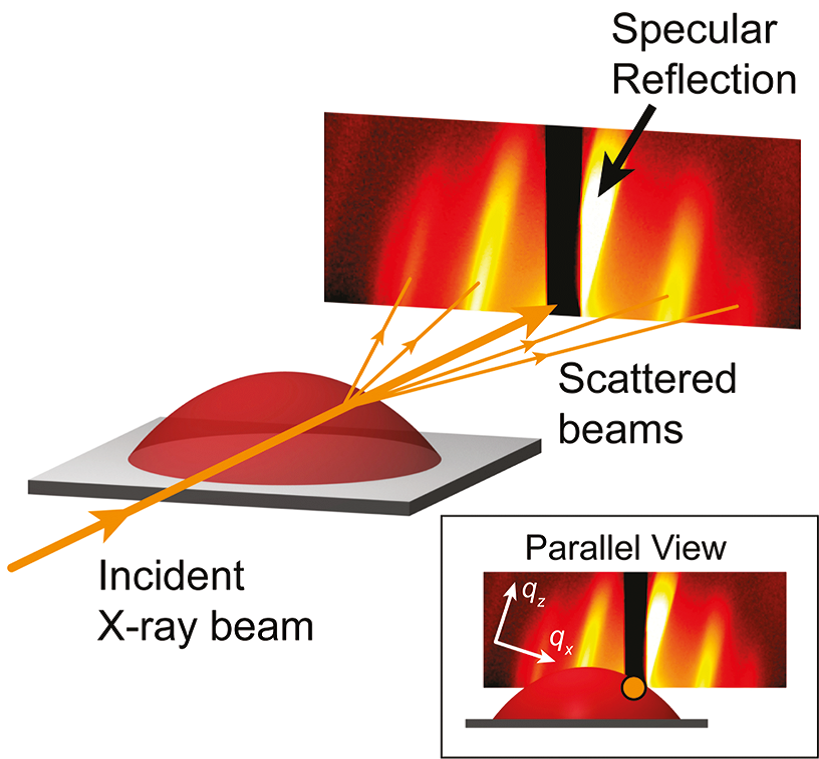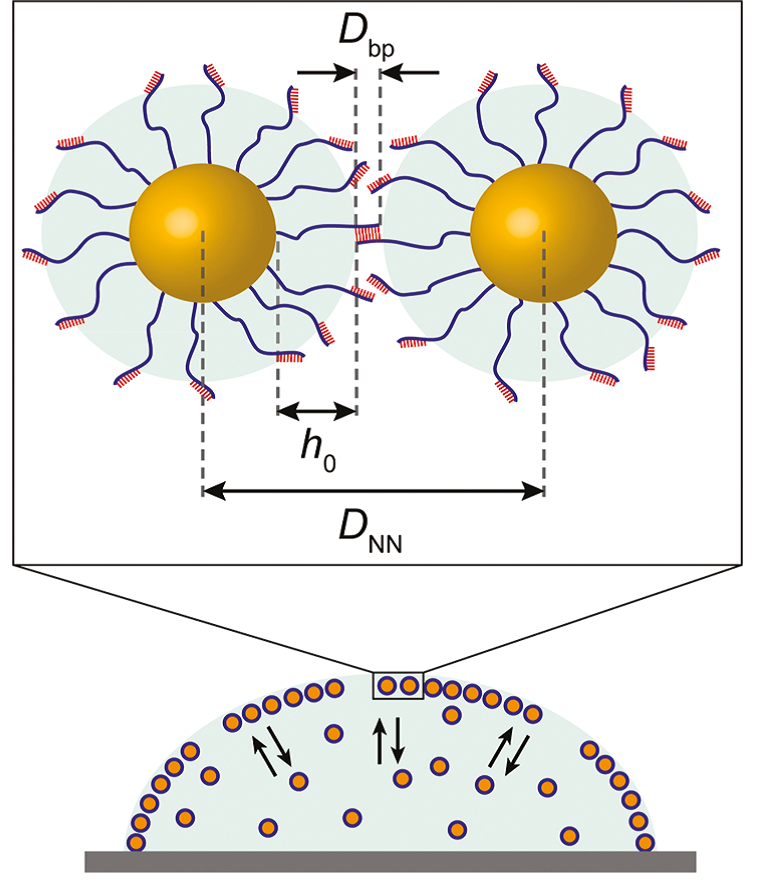X-RAY RUNS: Apply for Beamtime
2017 Nov 1 - Dec 21
2018 Feb 7 - Apr 3
2018 Proposal/BTR deadline: 12/1/17
2018 Apr 11 - Jun 4
2018 Proposal/BTR deadline: 2/1/18
DNA, the carrier of the genetic information, is a negatively charged macromolecule. For 2 DNA strands to be able to bind, positive counterions have to be added to the aqueous medium in form of salt, to screen the repulsive Coulomb force. Moreover, the salt concentration also determines whether the DNA strands are rather straight (low salt content) or coiled up (high salt content), as uncharged polymers typically are. If DNA strands are anchored on a nanoparticle, the height of the resulting DNA corona and thus the nanoparticle-nanoparticle distance can be controlled by the concentration of counterions.
In the case of the system studied by Mike Campolongo and his fellow students from the Luo group (Biological and Environmental Engineering, Cornell Univ.), with collaborators Prof. Wenlong Cheng (Monash Univ., Australia) and CHESS staff scientist Detlef Smilgies, short single DNA strands were attached to gold nanoparticles. The DNA strands had short base-pairing sequences at their free ends, but were otherwise non-binding. The researchers found that when a small drop of nanoparticle solution was deposited on a clean silicon wafer, hexagonally ordered monolayers of DNA-coated nanoparticles were formed at the surface of the drop. Such layers, in thermal equilibrium with the liquid nanoparticle solution in the interior of the drop, are known as Gibbs layers that were predicted in the seminal theoretical work by Willard Gibbs on thermodynamics at the end of the 19th century.
In order to characterize the crystallization of the Gibbs layers, the researchers devised a variant of Grazing Incidence Small-Angle X-ray Scattering (GISAXS) they termed “parallel SAXS”: A small x-ray beam is aligned parallel to the substrate surface so that only the apex of the drop is probed (Fig 1), and a reflection from the substrate is avoided. Moreover, also the bulk of the droplet can be probed this way and it was revealed that the interior of the droplet had not crystallized. The droplet was stabilized in a temperature- and humidity-controlled environment and detailed maps of the whole drop could be obtained, without drop evaporation.

Fig 1: Parallel SAXS: a drop of nanoparticle solution is deposited on a clean silicon wafer surface. A small x-ray beam is lined up parallel to the wafer surface. Thus the apex of the drop, its center, and even the base of the drop can be probed without reflection from the substrate. The drop is stabilized at fixed temperature and at equilibrium vapor pressure inside a sample cell. This “lab-on-a-drop” method facilitates the study of various parts of the system for hours, e.g. for detailed scans of the whole drop.
Such a “lab-on-a-drop” measurement constitutes a unique opportunity to study the response of the Gibbs layers to nanoparticle and counterion concentration. This can be done without lattice distortions that may occur, if the layer is stuck to a solid substrate, or in some other non-equilibrium situation, as temperature and vapor pressure were stabilized by the sample cell. Campolongo and coworkers found that the lattice spacing of the nanoparticles were a function of the counterion concentration, as described by the Daoud-Cotton model with added screening. Thus the DNA ligands were acting as charged entropic springs. Moreover, they found optimum quality of the monolayer at a 0.5mM NaCl concentration.

Functionalization and programmability of DNA coronae: Single-stranded DNA chains were anchored on the surface of citrate-coated gold nanoparticles by ligand exchange via a thiol bond. The free ends of the DNA chains feature palindromic base sequences that can bind to each other. The center part of the DNA ligands consist of non-binding poly-thymine chains, the conformation of which can be programmed by the concentration of counterions to screen the negative charge of the DNA chains. An ordered Gibbs layer formed at the surface of a drop of nanoparticle solution. Particles were kept in thermal equilibrium in the grand canonical ensemble using a “lab-on-a-drop” method to study the interaction of the DNA coronae undisturbed by environmental influences.
DNA-coated nanoparticles can be regarded as highly functionalizable and programmable agents to rationally design new metamaterials. Campolongo’s study revealed the part of the phase diagram where nanoparticle assembly via DNA binding becomes most favorable and also indicates how electrostatic screening can be used to fine tune DNA conformation, affecting the lattice constant of the whole nanoparticle assembly. Results were published in the recent issue of ACS Nano [1].
Note: Student team member Shawn Tan (Luo gorup) was awarded one of two poster prizes at the 2nd Nano Today Conference. This was out of about 300 poster contributions. Keep it up, Shawn!
Reference:
[1] Michael J. Campolongo, Shawn J. Tan, Detlef-M. Smilgies, Mervin Zhao, Yi Chen, Iva Xhangolli, Wenlong Cheng, and Dan Luo;
"Crystalline Gibbs Monolayers of DNA-Capped Nanoparticles at the Air–Liquid Interface", ACS Nano
5, 7978-7985 (2011)
Submitted by: Detlef Smilgies, CHESS, Cornell University
